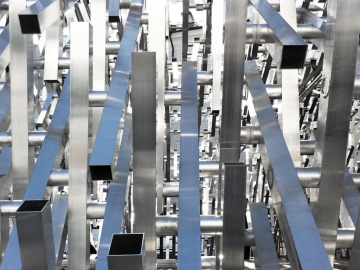Mobile Art Pavillon 'White Noise' (dismantled)
The temporary pavilion creates a unique venue for contemporary art productions in Salzburg, a city known predominantly for classical music. Its main user is the Salzburg Biennale, a contemporary music festival. During the next decade, it will be used for various events at different locations.
Art is a cultural process involving many participants within a discourse. It does not reveal itself at first sight, but unfolds through encounter and engagement. Emphasizing this idea the pavilions appearance provokes curiosity and invites visitors to encounter the unknown.
The architectural concept is based on a theme inherent in architecture as well as in music??rule and variation. The pavilions structure is based on a simple repetitive element, a set of rules for aggregation, and the definition of the architectural effects aimed for. Individual aluminium profiles of uniform length produce an irregular, mass-like conglomerate that changes in appearance throughout the day, according to the different light conditions. The structure allows an ambivalent reading, focusing either on the single members or on the integrated whole, depending on the viewers distance from the object. The mass-like appearance aims at underlining the creative character of our perception, since our brains are constantly trying to distinguish figures and patterns within disorder.
Bottom-up also expresses a speculative intention here: Rather than representing forms or meanings, the architecture produces an ambiguous mass to allow visitors come up with their own interpretations and associations. Besides Salzburg, the pavilion has been assembled in the rural valley Krakautal and in Maribor. The interior space allows for a variety of cultural uses on 140 square meters. Aluminium was not only chosen due to its lightness and durability that enables outdoor storing, it is also one of the most recycled materials with more than 70 percent of the original aluminium once produced still in use.








